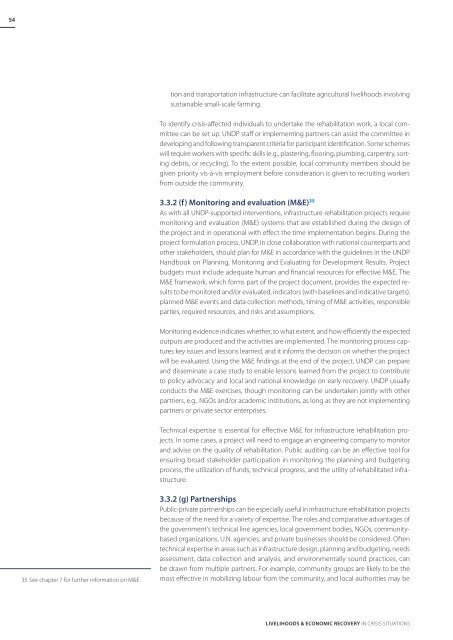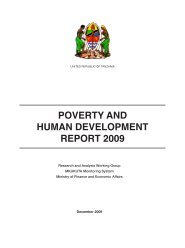Download PDF (4.08 MB) - ReliefWeb
Download PDF (4.08 MB) - ReliefWeb
Download PDF (4.08 MB) - ReliefWeb
You also want an ePaper? Increase the reach of your titles
YUMPU automatically turns print PDFs into web optimized ePapers that Google loves.
54<br />
tion and transportation infrastructure can facilitate agricultural livelihoods involving<br />
sustainable small-scale farming.<br />
To identify crisis-affected individuals to undertake the rehabilitation work, a local committee<br />
can be set up. UNDP staff or implementing partners can assist the committee in<br />
developing and following transparent criteria for participant identification. Some schemes<br />
will require workers with specific skills (e.g., plastering, flooring, plumbing, carpentry, sorting<br />
debris, or recycling). To the extent possible, local community members should be<br />
given priority vis-à-vis employment before consideration is given to recruiting workers<br />
from outside the community.<br />
3.3.2 (f) Monitoring and evaluation (M&E) 35<br />
As with all UNDP-supported interventions, infrastructure rehabilitation projects require<br />
monitoring and evaluation (M&E) systems that are established during the design of<br />
the project and in operational with effect the time implementation begins. During the<br />
project formulation process, UNDP, in close collaboration with national counterparts and<br />
other stakeholders, should plan for M&E in accordance with the guidelines in the UNDP<br />
Handbook on Planning, Monitoring and Evaluating for Development Results. Project<br />
budgets must include adequate human and financial resources for effective M&E. The<br />
M&E framework, which forms part of the project document, provides the expected results<br />
to be monitored and/or evaluated, indicators (with baselines and indicative targets),<br />
planned M&E events and data collection methods, timing of M&E activities, responsible<br />
parties, required resources, and risks and assumptions.<br />
Monitoring evidence indicates whether, to what extent, and how efficiently the expected<br />
outputs are produced and the activities are implemented. The monitoring process captures<br />
key issues and lessons learned, and it informs the decision on whether the project<br />
will be evaluated. Using the M&E findings at the end of the project, UNDP can prepare<br />
and disseminate a case study to enable lessons learned from the project to contribute<br />
to policy advocacy and local and national knowledge on early recovery. UNDP usually<br />
conducts the M&E exercises, though monitoring can be undertaken jointly with other<br />
partners, e.g., NGOs and/or academic institutions, as long as they are not implementing<br />
partners or private sector enterprises.<br />
Technical expertise is essential for effective M&E for infrastructure rehabilitation projects.<br />
In some cases, a project will need to engage an engineering company to monitor<br />
and advise on the quality of rehabilitation. Public auditing can be an effective tool for<br />
ensuring broad stakeholder participation in monitoring the planning and budgeting<br />
process, the utilization of funds, technical progress, and the utility of rehabilitated infrastructure.<br />
35 See chapter 7 for further information on M&E.<br />
3.3.2 (g) Partnerships<br />
Public-private partnerships can be especially useful in infrastructure rehabilitation projects<br />
because of the need for a variety of expertise. The roles and comparative advantages of<br />
the government’s technical line agencies, local government bodies, NGOs, communitybased<br />
organizations, U.N. agencies, and private businesses should be considered. Often<br />
technical expertise in areas such as infrastructure design, planning and budgeting, needs<br />
assessment, data collection and analysis, and environmentally sound practices, can<br />
be drawn from multiple partners. For example, community groups are likely to be the<br />
most effective in mobilizing labour from the community, and local authorities may be<br />
Livelihoods & Economic Recovery in Crisis Situations





